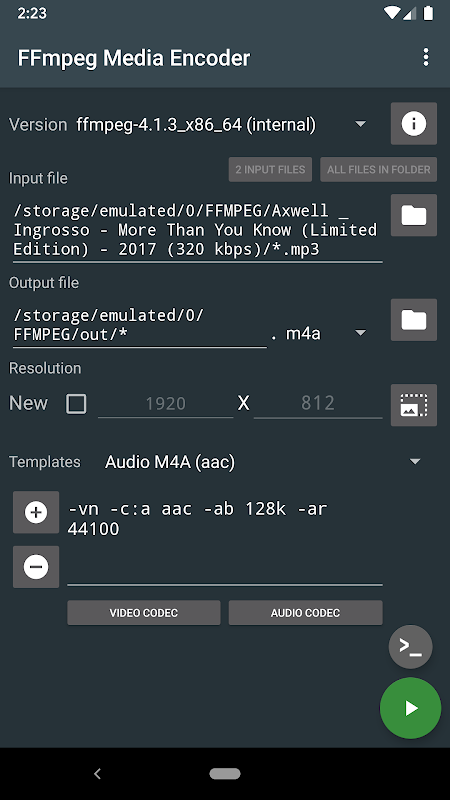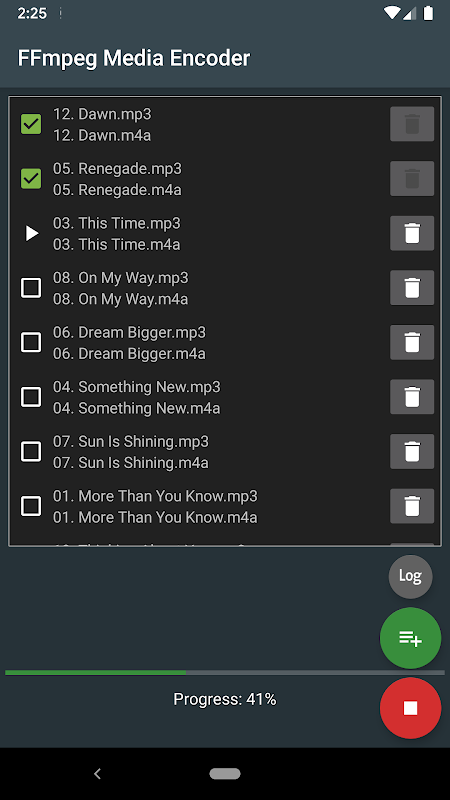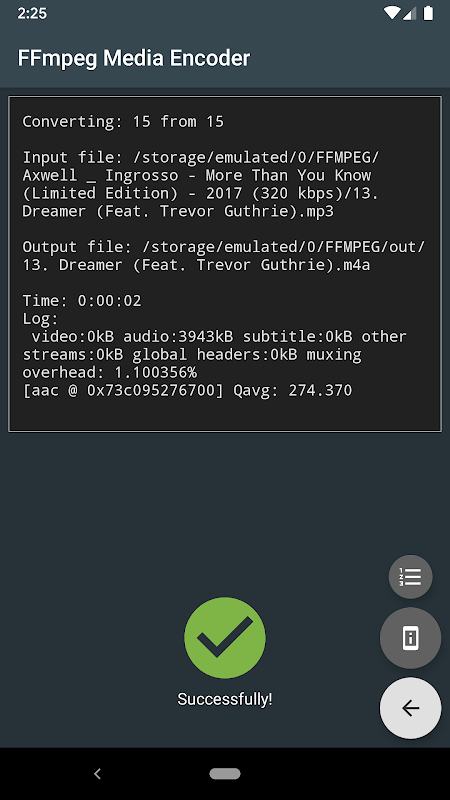Convert audio and video directly on the device using FFmpeg http://ffmpeg.org/
FFmpeg is a set of open source libraries that allow you to record, convert digital audio and video recordings in various formats. It includes libavcodec, a library for encoding and decoding audio and video, and libavformat, a library for multiplexing and demultiplexing into a media container. The name comes from the name of the MPEG and FF expert group, meaning fast forward.
FFmpeg is already built into the program and does not require downloading additional codecs.
The conversion takes place directly on the device (the Internet is not required), and the conversion speed depends on the processor speed of the device.
Supports: MPEG4, h265, h264, mp3, 3gp, aac, ogg (vorbis and theora), opus, vp8, vp9 and many other formats (you will find the list in the app).
Requirements: Android 4.4 and the availability of the processor ARMv7, ARMv8, x86, x86_64.
FFmpeg with x264, x265, ogg, vorbis, theora, opus, vp8, vp9, mp3lame, libxvid, libfdk_aac, libvo_amrwbenc, libopencore-amr, speex, libsox, libwavpack, libwebp, librtmp
More options can be found in the help pages for FFmpeg.
For Android 11 users: New rules require the application to use more confidential methods of working with files on your device. You will have to copy/move the input files to a shared folder, such as DCIM, Movie, Music, Download. Sorry for the inconvenience
Overview
FFmpeg Media Encoder is a powerful cross-platform tool for encoding and transcoding video and audio files. It supports a wide range of input and output formats, codecs, and resolutions, making it a versatile solution for a variety of media production needs.
Features
* Extensive format support: FFmpeg Media Encoder supports a wide range of video and audio formats, including MP4, MKV, AVI, MOV, FLV, and MP3.
* Codec support: The encoder supports a variety of video and audio codecs, including H.264, H.265, MPEG-4, VP9, AAC, and MP3.
* Resolution and bitrate options: Users can specify the desired resolution and bitrate for their encoded files, allowing for optimization for different devices and applications.
* Filtering and effects: FFmpeg Media Encoder includes a range of filters and effects that can be applied to video and audio files during encoding. These include cropping, scaling, color correction, and audio equalization.
* Multi-pass encoding: FFmpeg Media Encoder supports multi-pass encoding, which can improve the quality of the encoded files at the cost of increased encoding time.
* Command-line interface: FFmpeg Media Encoder is primarily operated through a command-line interface, providing advanced users with flexibility and control over the encoding process.
* Cross-platform compatibility: FFmpeg Media Encoder is available for Windows, macOS, Linux, and other operating systems, making it accessible to users on a variety of platforms.
Applications
FFmpeg Media Encoder is used in a wide range of applications, including:
* Video conversion: Converting video files between different formats and codecs for playback on different devices or for editing purposes.
* Video compression: Reducing the file size of video files while maintaining acceptable quality, suitable for sharing or storage.
* Video editing: Preparing video files for editing in non-linear editing software by converting them to a suitable format and resolution.
* Audio extraction: Extracting audio tracks from video files for use in other projects or for standalone listening.
* Media streaming: Encoding video and audio files for streaming over the internet or local networks.
Benefits
* Open source and free: FFmpeg Media Encoder is open source and free to use, making it accessible to a wide range of users.
* Powerful and versatile: The encoder's extensive format and codec support, along with its filtering and effects capabilities, make it a powerful tool for a variety of media production tasks.
* Cross-platform: The availability of FFmpeg Media Encoder on multiple platforms allows users to work on their projects regardless of their operating system.
* Command-line interface: The command-line interface provides advanced users with precise control over the encoding process and allows for scripting and automation.
Convert audio and video directly on the device using FFmpeg http://ffmpeg.org/
FFmpeg is a set of open source libraries that allow you to record, convert digital audio and video recordings in various formats. It includes libavcodec, a library for encoding and decoding audio and video, and libavformat, a library for multiplexing and demultiplexing into a media container. The name comes from the name of the MPEG and FF expert group, meaning fast forward.
FFmpeg is already built into the program and does not require downloading additional codecs.
The conversion takes place directly on the device (the Internet is not required), and the conversion speed depends on the processor speed of the device.
Supports: MPEG4, h265, h264, mp3, 3gp, aac, ogg (vorbis and theora), opus, vp8, vp9 and many other formats (you will find the list in the app).
Requirements: Android 4.4 and the availability of the processor ARMv7, ARMv8, x86, x86_64.
FFmpeg with x264, x265, ogg, vorbis, theora, opus, vp8, vp9, mp3lame, libxvid, libfdk_aac, libvo_amrwbenc, libopencore-amr, speex, libsox, libwavpack, libwebp, librtmp
More options can be found in the help pages for FFmpeg.
For Android 11 users: New rules require the application to use more confidential methods of working with files on your device. You will have to copy/move the input files to a shared folder, such as DCIM, Movie, Music, Download. Sorry for the inconvenience
Overview
FFmpeg Media Encoder is a powerful cross-platform tool for encoding and transcoding video and audio files. It supports a wide range of input and output formats, codecs, and resolutions, making it a versatile solution for a variety of media production needs.
Features
* Extensive format support: FFmpeg Media Encoder supports a wide range of video and audio formats, including MP4, MKV, AVI, MOV, FLV, and MP3.
* Codec support: The encoder supports a variety of video and audio codecs, including H.264, H.265, MPEG-4, VP9, AAC, and MP3.
* Resolution and bitrate options: Users can specify the desired resolution and bitrate for their encoded files, allowing for optimization for different devices and applications.
* Filtering and effects: FFmpeg Media Encoder includes a range of filters and effects that can be applied to video and audio files during encoding. These include cropping, scaling, color correction, and audio equalization.
* Multi-pass encoding: FFmpeg Media Encoder supports multi-pass encoding, which can improve the quality of the encoded files at the cost of increased encoding time.
* Command-line interface: FFmpeg Media Encoder is primarily operated through a command-line interface, providing advanced users with flexibility and control over the encoding process.
* Cross-platform compatibility: FFmpeg Media Encoder is available for Windows, macOS, Linux, and other operating systems, making it accessible to users on a variety of platforms.
Applications
FFmpeg Media Encoder is used in a wide range of applications, including:
* Video conversion: Converting video files between different formats and codecs for playback on different devices or for editing purposes.
* Video compression: Reducing the file size of video files while maintaining acceptable quality, suitable for sharing or storage.
* Video editing: Preparing video files for editing in non-linear editing software by converting them to a suitable format and resolution.
* Audio extraction: Extracting audio tracks from video files for use in other projects or for standalone listening.
* Media streaming: Encoding video and audio files for streaming over the internet or local networks.
Benefits
* Open source and free: FFmpeg Media Encoder is open source and free to use, making it accessible to a wide range of users.
* Powerful and versatile: The encoder's extensive format and codec support, along with its filtering and effects capabilities, make it a powerful tool for a variety of media production tasks.
* Cross-platform: The availability of FFmpeg Media Encoder on multiple platforms allows users to work on their projects regardless of their operating system.
* Command-line interface: The command-line interface provides advanced users with precise control over the encoding process and allows for scripting and automation.












